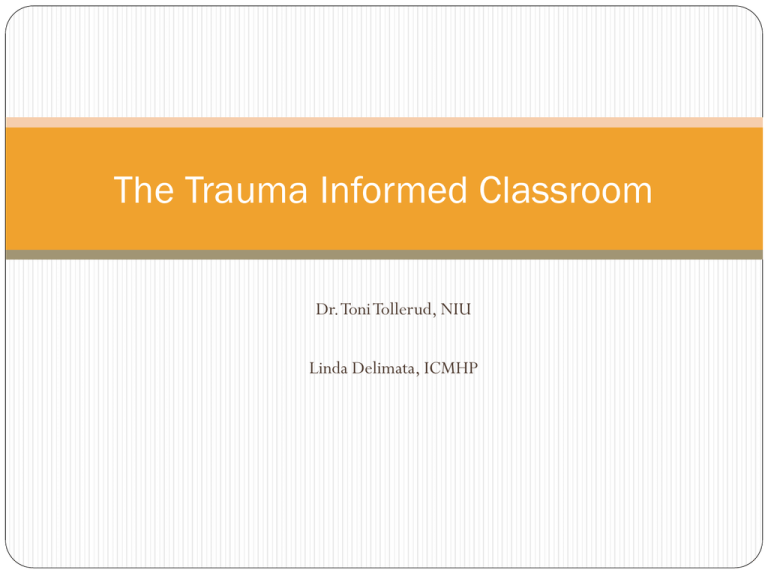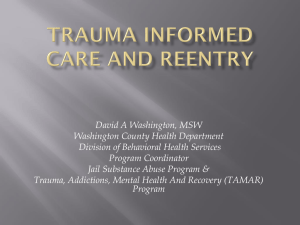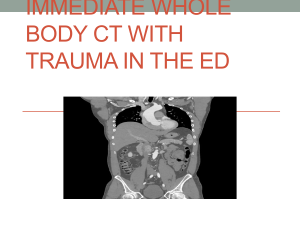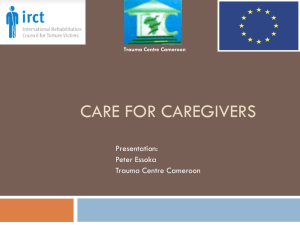The Trauma Informed Classroom
advertisement

The Trauma Informed Classroom Dr. Toni Tollerud, NIU Linda Delimata, ICMHP ACES Study Built upon a conceptual framework that risk factors for disease and other physical ailments are strongly affected by adverse childhood experiences. The study assesses what might be considered “scientific gaps” about the origins of risk factors. This study takes a whole life perspective. If childhood stressors can be identified, we might be able to provide early intervention or utilize protective factors that would reduce the risk. Adverse Childhood Experiences (ACEs) Growing up in a household with: Verbal Abuse Recurrent physical, sexual or emotional abuse Emotional or physical neglect Domestic violence between parents An alcoholic Substance abuser An incarcerated household member Someone who is chronically depressed, suicidal, institutionalized or mentally ill Live with One or no biological parents (2006, http://www.acestudy.org/) Consequences Of Unresolved Trauma (2004, http://www.acestudy.org/) Findings of the Study Over 17,000 people participated in the study Almost 2/3 experienced at least one ACE Over ¼ reported one ACE Over 25% reported 2 or more Over 12% reported 4 or more. One out of 8 Higher ACES scores = Higher scores = increased risk for health problems Strong relationship to health-related behaviors during childhood & adolescence including smoking, early sexual activity, illicit drug use, teen pregnancies, and suicide attempts. What is Stress? Stress is defined as a process that exists over time. When is continues, it can often lead to a debilitating outcomes as it accumulates. Stress affects all aspects of ones functioning Collins & Collins (2005) When a child encounters a perceived threat to their safety, their brains trigger a complex set of chemical and neurological events known as the “stress response”. Massachusetts Advocates for Children (2005) Stress and the Body & Brain Stress is the set of changes in the body and the brain that are set into motion when there are overwhelming threats to physical or psychological well-being. Under threat, the limbic system engages and the frontal lobes disengage. When safety returns, the limbic chemical reaction stops and the frontal lobes re-engage. (van der Kolk, B., 2005) Reactions to Stress and Trauma Fight Freeze Flee Under normal circumstances these responses to stress are constructive and help keep a child or adolescent safe. However, when a child is traumatized, and is overwhelmed with stress and fear, these responses can become a regular mode of functioning. Consequently, a youth may react to their world even when the dangers are NOT present because they cannot turn off the survival strategies in their brains. Traumatic Stress and Critical Windows of Brain Development Cortex Limbic Brain Mid Brain Brain Stem cognitive functioning: 12 months - 48 months emotional functioning: 6 months - 30 months motor functioning: first year state regulation: pre-birth - 8 months (Adapted from: Perry, 2002) The Impact of Extreme Trauma on Brain Development 1997, Bruce D. Perry, M.D., Ph.D. Explicit and Implicit Memory CORTEX: HIPPOCAMPUS: higher level thought processes, planning, problem solving Explicit memory governs recollection of facts, events or associations AMYGDALA: Adrenal gland Implicit memory – No conscious awareness (procedural memory – e.g., riding a bike and emotional memorye.g., fear) Chronic stress = overstimulation of the Amygdala, resulting in the release of cortisol, possible shrinkage or atrophy of the Hippocampus and Cortex, affecting memory and cognition, and leading to anxiety or depression. (Adapted from: Brunson, Lorang, & Baram, 2002) What is Trauma? Trauma is a serious physical or psychological injury that has resulted from a highly threatening, terrifying, or horrifying experience. (Echterling, Presbury & McKee, 2005) Trauma arises from an inescapable stressful event that overwhelms an individuals’ coping mechanisms. (van der Kolk & Fisler, 1995). Trauma Can Be….. Characterized as more than simple loss Dependent upon an actual event Dependent upon a child’s proximity to the traumatic event Dependent upon the number of risk factors that confront a child Dependent upon a child’s age “In a study that assess adolescent females who witness or experienced violence, 67 % met the diagnosis for PTSD” CIVITAS (2002) Physiological Effects Perpetual extreme levels of stress arousal may lead to: hypervigilance and loss of ability to concentrate altered vision and hearing hyperactivity or dissociation avoidance of potential triggers to trauma altered sleep patterns altered eating patterns compulsive self harm attempts to self medicate with substances (Cairns, K. & Stanway, S., 2004.) Physical Effects Continued stress arousal may lead to: headaches digestive disorders respiratory disorders other psychosomatic illnesses muscle tension aching joints clumsiness altered spatial awareness (Cairns, K. & Stanway, S., 2004.) Emotional Effects Inability to process emotions through language Diminished capacity for empathy Hypersensitivity to trauma in others Diminished range of emotions: terror or rage Depression or sadness Feelings of worthlessness and shame Bad memories Recurring outbreaks Dissociation (Cairns, K. & Stanway, S., 2004; CIVITAS, 2002) Social Effects May become socially isolated or member of deviant peer group due to: Extreme reactions of terror or rage Diminished empathy limits social connectedness Survival mode restricts motivation to be sociable Avoidance restricts capacity to connect to others Diminished language restricts social accountability Traumatic identity leads to persistent victim or aggressor behaviour (Cairns, K. & Stanway, S., 2004.) Cognitive Effects Negative cognitive reactions affect how a youth processes information and performs advanced thinking. Inability to remember details Memory impairment Poor attention Unable to concentrate Lack of goals Poor problem solving Sense of shortened future CIVITAS ( 2002) Response to Trauma Infants (Birth -2 ½ year) Eating disturbances Irritable, difficult to soothe Developmental regression Language delay Attachment disorder Failure to thrive Sleep disturbance DCFS Trauma Training, 2006 Response to Trauma Young Children (2 ½ 6 years) Helplessness and Passivity Generalized Fear Confusion, difficulty planning Difficulty identifying what is bothering them Attributing magical qualities to traumatic reminders Fighting or threatening behavior Attention Problems Sadness/Depression Separation Anxiety Specific Fears DCFS Trauma Training, 2006 Response to Trauma School-age Children (6-11year) Physical complaints Bedwetting School failure/absenteeism Behavioral problems Attention problems Fighting or threatening behaviors Guilt feelings Acting like a parent to siblings Depression DCFS Trauma Training, 2006 Response to Trauma Adolescents (12 to 18 years) Antisocial behavior Runaway Depression/Suicidal thought Sleep Disorders Absenteeism Acting like a parent to siblings Eating Disorders Dating violence Substance abuse School failure Relationship problems DCFS Trauma Training, 2006 Most Frequent Difficulties Following Chronic Trauma 75% 61.5% 59.2% 57.9% 60% 53.1% 45.8% 45% 30% 15% g kta kin tro on C Ri s e ls Ag gr e ss io n/ Im pu lfSe e eg at iv N l ag e Im tio ra ce nt tio te n At Af fe c n/ C on tD ys re gu la tio n n 0% (Spinazzola.J, et.al., 2005) Relationship Between Diagnoses & Eligibilities Special Education Eligibility: Psychological/Neurobiological Diagnosis: Traumatic Stress Emotional Disturbance Inability to learn not explained by health, intellectual, or sensory disability; Inability to build/maintain relationships; Inappropriate behavior or feelings under normal circumstances; Pervasive anxiety or depression; Physical symptoms or fears. Rarely in attentive state Defiant, aggressive, oppositional Hyperarousal Internalizing disorders Fear, somatic disorders Special Education Eligibility: Specific Learning Disability Disorder in basic psychological processes involved in understanding/using language, spoken or written, may manifest in an imperfect ability to listen, think, speak, read, write, spell, or do mathematical calculations. Rarely in attentive state; Lack of concentration; Misperceptions; Avoidance; Dissociation; Repeated intrusive memories (Shumow & Perry, 2006) Trauma’s Impact on Learning Inability to process social cues and to convey feelings in an appropriate manner. ACADEMIC PERFORMANCE DIFFICULTIES CLASSROOM BEHAVIORS Language & communication skills Learning and retrieving new verbal information Problem-solving Goal setting Lack capacity for self-regulation Distorted world view Reactivity and impulsivity Aggression Defiance Withdrawal Perfectionism Protective Factors Some children who are exposed to traumatic events appear to be more resilient than others. What are those factors that protect the children from the risks of the trauma? Common Protective Factors for Child Abuse and Neglect Protective Factors fall into three basic categories: Child Protective Factors Parental/Family Protective Factors Social/Environmental Protective Factors Child Welfare Information Gateway, www.childwelfare.gov/preventing/programs/whatworks/riskprotectivefac tors.cfm. Child Protective Factors Good health Above average intelligence Hobbies and interests Good peer relationships Personality factors temperament, disposition, coping style, positive self-esteem, social skills, internal locus of control Child Welfare Information Gateway, www.childwelfare.gov/preventing/programs/what works/riskprotectivefactors.cfm. Parental/Family Protective Factors Positive and warm relationships Supportive family environments Clear boundaries and consistent follow-through Help from extended family Stable relationship with parents Role models Family expectations of pro-social skills Parental education Child Welfare Information Gateway, www.childwelfare.gov/preventing/programs/whatworks/riskp rotectivefactors.cfm. Social/Environmental Protective Factors Mid to high socioeconomic status Access to health care and social services Parental employment Participation in faith based activities Good schools Supportive adults Child Welfare Information Gateway, www.childwelfare.gov/preventing/programs/whatworks/riskprotectivefactors.cfm. Mental Health Mental health is the “successful performance of mental function resulting in productive activities, fulfilling relationships with other people, and the ability to adapt to change and to cope with adversity.” Department of Health and Human Services (1999) Mental Health: A Report of the Surgeon General Social Emotional Learning SEL is the process of acquiring the skills to recognize and manage emotions, develop caring and concern for others, establish positive relationships, make responsible decisions, and handle challenging tasks effectively. Collaborative for Academic, Social, and Emotional Learning (2005). Safe and Sound, IL Edition What are the Core SEL Competencies? Recognizing one’s emotions and values as well as one’s strengths and limitations Managing emotions and behaviors to achieve one’s goals Selfawareness Selfmanagement SEL Social awareness Responsible decisionmaking Relationship Skills Showing understanding and empathy for others Graphic: CASEL Making ethical, constructive choices about personal and social behavior Forming positive relationships, working in teams, and dealing effectively with conflict Approaches to Helping Traumatized Students Learn Understand the needs of the students Create a trauma-sensitive school environment where needs are addressed Connect with families and communities, mental health and child welfare staff, and others as part of the social and professional network to support the recovering child Curriculum for Helping Your School Create a Trauma Sensitive Environment The Massachusetts Advocates for Children provides a free resource to download at http://www.massadvocates.org/helping_traumatized_children _learn. Steps to Building a Trauma-Sensitive Perspective in Your School Change the School-Wide Infrastructure and Culture of the school School leadership and administrators need to build into the SIP or school-wide plan a way to integrate trauma-sensitive routines into the school The school must weave trauma-sensitive approaches across the fabric of the school All stakeholders need to identify and address barriers to incorporating trauma sensitive approaches into the school Massachusetts Advocates for Children (2005) Steps to Building a Trauma-Sensitive Perspective in Your School Train Staff to do three important tasks: Strengthen relationships between children and adults and convey the fact that staff are caring adults in the lives of traumatized youth and their caregivers Identify and use outside supports and resources Help youth modulate their emotions and gain social and academic acceptance SEL Role of the Counselor is paramount here Massachusetts Advocates for Children (2005) Steps to Building a Trauma-Sensitive Perspective in Your School Begin the process of a school-wide Implementation of Social and Emotional Learning SEL enhances factors that help traumatized children do better in school: - creates a safer environment - helps make closer connections with others - teachers the skills needed to move through our world - helps students perform to their fullest potential How Safe is Your School? What things are you seeing in your school that might be problematic for youth who have experienced trauma/ What kinds of things does your school do to promote the safety of all students? What might your school do to enhance the safety of your school? What supports or resources do you need? Steps to Building a Trauma-Sensitive Perspective in Your School What teachers and counselors can do: Maintain high academic standards Help students feel safe Teach students how to manage behaviors and set limits Reduce bullying and harassment Provide youth with a sense of agency—youth need to be able to make choices which strengthens their sense of empowerment Build on strengths Understand the connection between behavior and emotion Avoid labels Massachusetts Advocates for Children (2005) Steps to Building a Trauma-Sensitive Perspective in Your School Link with Mental Health Professionals in the School and Community Be sure they are trauma sensitive providers Create classrooms that address the needs of traumatized children in academic instruction Help teachers to learn teaching techniques that support these students. Work from a students area of competence Reinforce student success Establish routines for students-make things predictable Focus on the timing of lessons and activities Describe plans in detail Use language-based teaching approaches Identify and process feelings Massachusetts Advocates for Children (2005) Steps to Building a Trauma-Sensitive Perspective in Your School Build Non-academic relationships with youth Develop policies and protocol for students regarding discipline, safety, confidentiality Balance accountability with understanding traumatic behavior Massachusetts Advocates for Children (2005) • Keep in mind the role that trauma plays in so many aspects of a child’s world. • Ask yourself if the behaviors being exhibited are affected by trauma as well as other concerns, and if co-morbidity exists how to approach the intervention for that child. • By seeing the relationship of learning and social problems in the child’s environment we can better impact their success by unifying our approach. Resources: www.cdc.gov/nccdphp/ACE www.massadvocates.org www.acestudy.org www.icmhp.org www.childwelfare.gov/preventing/programs/whatworks/riskprotectivefactors.cfm www.casel.org








